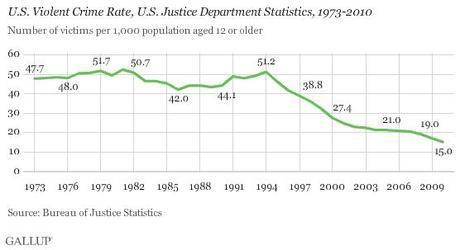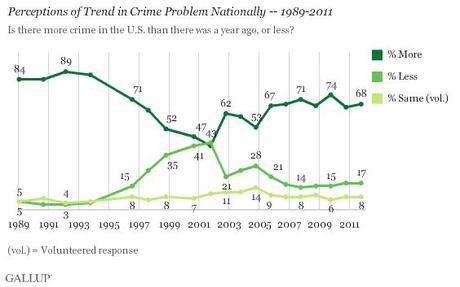
By Alan Bean
Ask most people if violent crime rates are rising or dropping and most will pick the pessimistic option. The chart above shows how dramatically violent crime rates have been dropping since the early 1990s. If you get most of your information from watching television, you’d think the nation was drowning in a tidal wave of blood. Sex and violence, often in lurid combination, grab and hold the attention of prime time viewers, so that’s what we get, all the time. The more bizarre, twisted and disturbing the better. The acting and story lines in the Sopranos, Dexter, Boardwalk Empire and Breaking Bad are unsurpassed, but minus the gratuitous violence, these programs would lose much of their audience appeal. The entertainment world’s fascination with serial murder is particularly over the top.
Falling crime rates are bad for the ratings, but the latest outrage is a sure headline grabber. So the average American can be forgiven for thinking that crime is getting worse every year.

In 2009, according to a Gallup study, only 15% of respondents thought violent crime was decreasing while 74% believed it was getting worse. The opposite is true, especially in New York City. In 1990, 2,262 people were murdered in Gotham; this year the number was 333. That’s not a typo: 333.
To be fair, that still amounts to a murder rate of around 4.5 per 100,000 population, compared to a rate of around 1 per 100,000 in western Europe. But compared to recent decades, the progress has been phenomenal.
As David Kennedy explains in the article below, New York City is a bit of an outlier. Still, most big American cities, including Detroit and New Orleans, have also reported a considerable drop in violent crime. Washington, DC and Baltimore continue to defy the positive trend.
How do we explain these numbers? As Christopher Mathias observes in the Huffington Post,
Mayor Michael Bloomberg and NYPD Commissioner Ray Kelly have previously attributed the steep decline in the city’s murder rate to an aggressive stop-and-frisk policy. Statistics show, however, that 2013′s historically low murder rate coincided with a 60 percent drop in police stops.
Most murders in the United States are gang related and occur in a handful of high-poverty neighborhoods. This may account for much of the drop in the Big Apple: increasingly, poor people can’t afford to live there. A third of NYC residents pay over half their income in rent. As gentrification spreads, poor people move out and crime rates drop.
The end of the crack epidemic is also part of the explanation. The crazy murder rates of the 1990s were largely a product of crack-related chaos. As crack use declines and markets stabilize, the murder rate falls.
In addition, the population is aging. If you can make it to 24 without committing a violent crime, you will probably be okay for the rest of your life. Violent crimes are uniquely the province of adolescents and young adults.
Following Randall Roth’s argument in American Homicide, I am inclined to believe that the election of the nation’s first Black president accounts for a small but significant portion of the drop in violent crime. Roth associates high homicide rates with social alienation and the loss of hope. If you want to know what that looks like in poor Black inner city neighborhoods watch a few seasons of The Wire. What does it mean for the young residents of these communities to have a president who looks like them? It is hard to exaggerate the effect. Since young Black males are far more likely to be both the perpetrators and victims of violent crime, a small down-tick in the alienation index can make a big difference. I wish the conservative true believers, who see Obama as the Antichrist, a socialist, and a Muslim terrorist worthy of impeachment, could look at the world through the eyes of a jobless high school dropout on the poor side of Chicago. It would help.
Murders Dip Everywhere, But NYC in a League of Its Own
‘The largest and most consistent decline in serious crime of any city in the country’
By Noah Rayman Sept. 27, 2013In 1990, a whopping 23,000 people were murdered in America. But when New York City announced Thursday that its murder rate was on track to reach a historic low, it was just the latest reminder of a nationwide plummet in murders over the last two decades.
And while the trend has been widespread — murders were down all the way to 14,000 nationwide last year from the 23,000 mark in 1990 — the improvement has been especially stunning in the Big Apple, criminologists say.
“New York has had the largest and most consistent decline in serious crime of any city in the country,” said David Kennedy, a professor at the John Jay College of Criminal Justice and director of the Center for Crime Prevention and Control. “The scale and the trajectory and the consistency is unique nationally.”
New York police boasted of their latest improvements Thursday, heralding a 27 percent drop in murders so far this year that, if maintained, would see the country’s largest city suffer less than one murder a day on average in 2013.
In 1990, the city could claim nearly 10 percent of all U.S. murderes. That year, the city’s most violent, 2,245 people were murdered. In 2012, the city reported 419 murders, just 3 percent of U.S. murders.
The city now has among the lowest murders rates — defined as murders per 100,000 people — of large cities. In 2012, New York City had a murder rate of about 5.0, below Los Angeles’ rate of 7.8, and less than a third of Chicago’s rate, where murders spiked before showing signs of slowing this year.
Across the country, murder rates fell precipitously in the 1990s at the tail end of the crack cocaine-induced drug wars. The figures leveled out in the 2000s, until 2009, when murder rates fell again over the next two years. The drop came as a surprise to law enforcement officials, who expected the economic recession to have a negative effect on crime, according to Alfred Blumstein, a criminologist at Carnegie Mellon University and author of The Crime Drop in America.
In New York, by contrast, homicides have dropped in all but four years since 2000.
The reasons behind New York’s exceptional drop are often debated — outgoing Mayor Michael Bloomberg has held up the controversial police tactic of stop-and-frisk as a major driver despite criticism that it amounts to little more than racial profiling — but Kennedy says innovative policing in general has left its mark. More recently, for example, New York police began targeting gang violence by closely monitoring the social and family circles of criminals, and by paying closer mind to social media use by gang members.
Outside the reach of law enforcement, rising incomes and real estate have transformed entire urban neighborhoods in New York, said Eugene O’Donnell, a former city cop who lectures at John Jay College.
“We kept saying how low can you go, and they’re still going lower,” O’Donnell said. “Increasingly, we’re seeing that New York City stands alone. While law enforcement certainly has played a role, there other dynamics that are going on in the city that put it in a class by itself.”
